Management and Culture: Taylorism Application and Cultural Comparison
VerifiedAdded on 2023/06/13
|7
|1749
|114
Essay
AI Summary
This essay explores two key areas: the application of Taylorism (scientific management theory) in the workplace, specifically within call centers to enhance productivity and efficiency, and a comparison of the cultural differences between Australia and India. Regarding Taylorism, the essay details how principles like job segregation, teamwork, and cooperation can be implemented to improve call center operations. In comparing Australian and Indian cultures, the essay highlights differences in social systems, religion, language, and politics, noting India's reserved culture versus Australia's emulation of Western norms. The analysis of Australian culture reveals a strong emphasis on individualism and resilience, with a preference for achievable challenges. The essay concludes by summarizing the core tenets of Taylorism and underscoring the significant sociocultural distinctions between Australia and India.
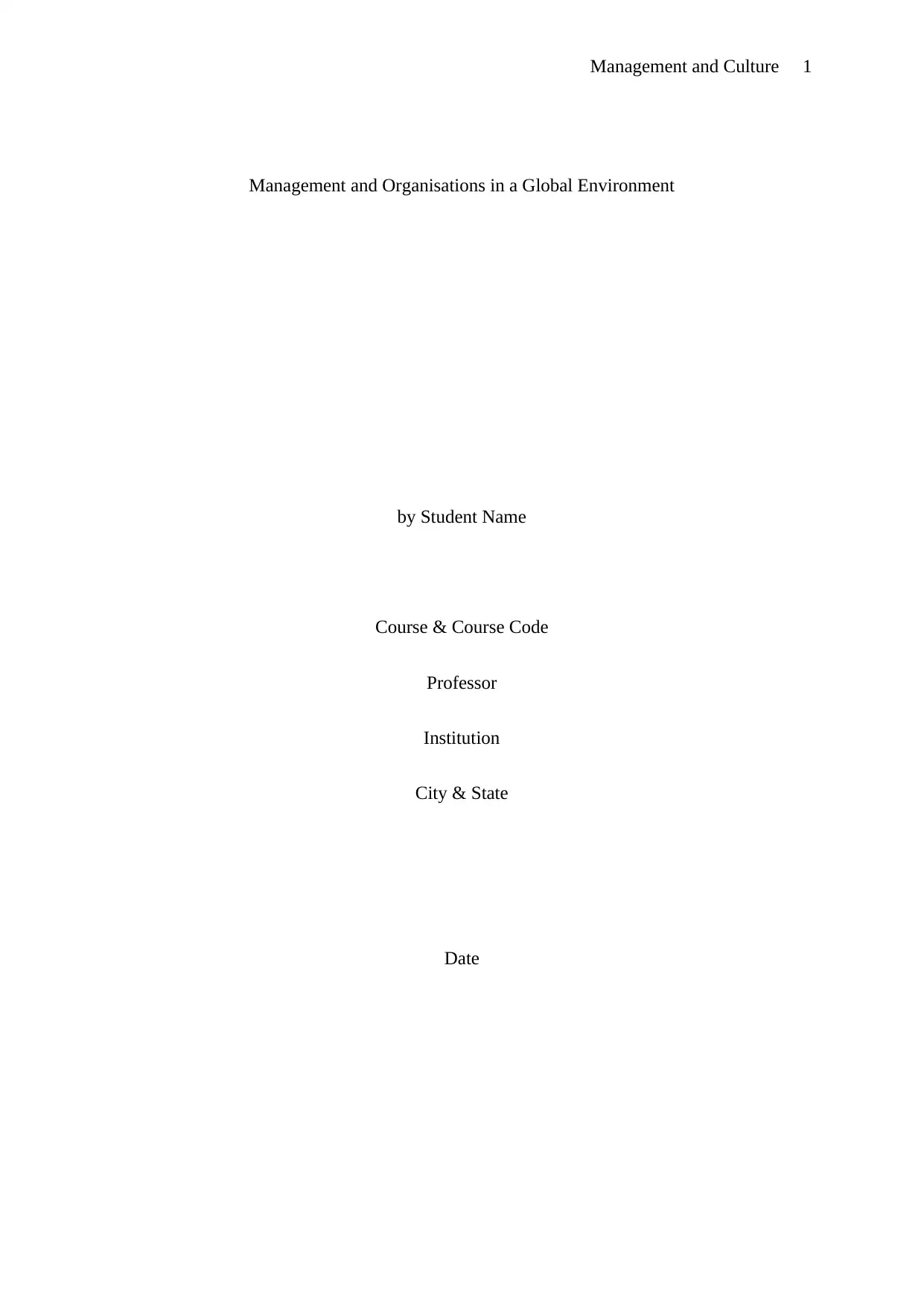
Management and Culture 1
Management and Organisations in a Global Environment
by Student Name
Course & Course Code
Professor
Institution
City & State
Date
Management and Organisations in a Global Environment
by Student Name
Course & Course Code
Professor
Institution
City & State
Date
Paraphrase This Document
Need a fresh take? Get an instant paraphrase of this document with our AI Paraphraser
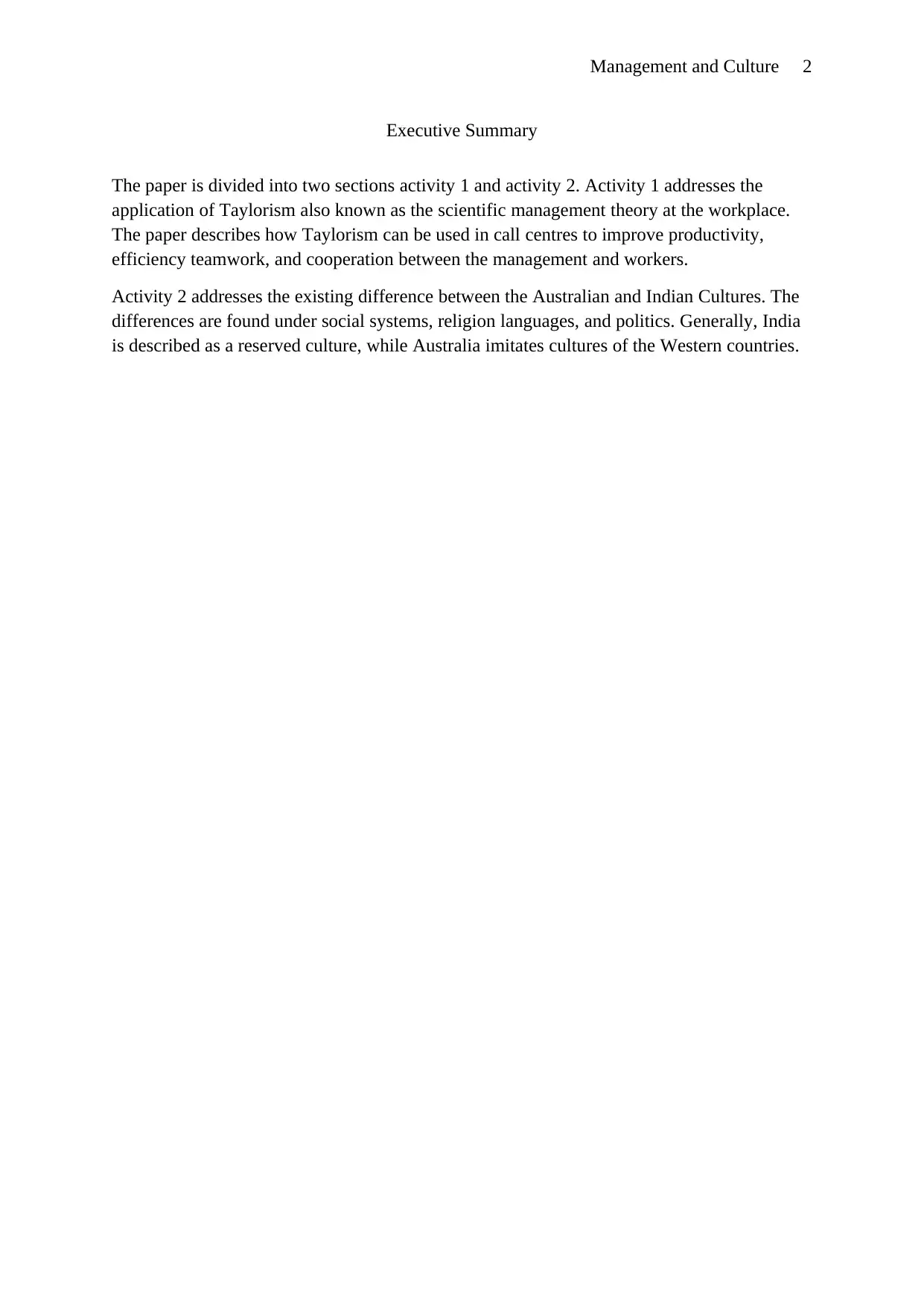
Management and Culture 2
Executive Summary
The paper is divided into two sections activity 1 and activity 2. Activity 1 addresses the
application of Taylorism also known as the scientific management theory at the workplace.
The paper describes how Taylorism can be used in call centres to improve productivity,
efficiency teamwork, and cooperation between the management and workers.
Activity 2 addresses the existing difference between the Australian and Indian Cultures. The
differences are found under social systems, religion languages, and politics. Generally, India
is described as a reserved culture, while Australia imitates cultures of the Western countries.
Executive Summary
The paper is divided into two sections activity 1 and activity 2. Activity 1 addresses the
application of Taylorism also known as the scientific management theory at the workplace.
The paper describes how Taylorism can be used in call centres to improve productivity,
efficiency teamwork, and cooperation between the management and workers.
Activity 2 addresses the existing difference between the Australian and Indian Cultures. The
differences are found under social systems, religion languages, and politics. Generally, India
is described as a reserved culture, while Australia imitates cultures of the Western countries.
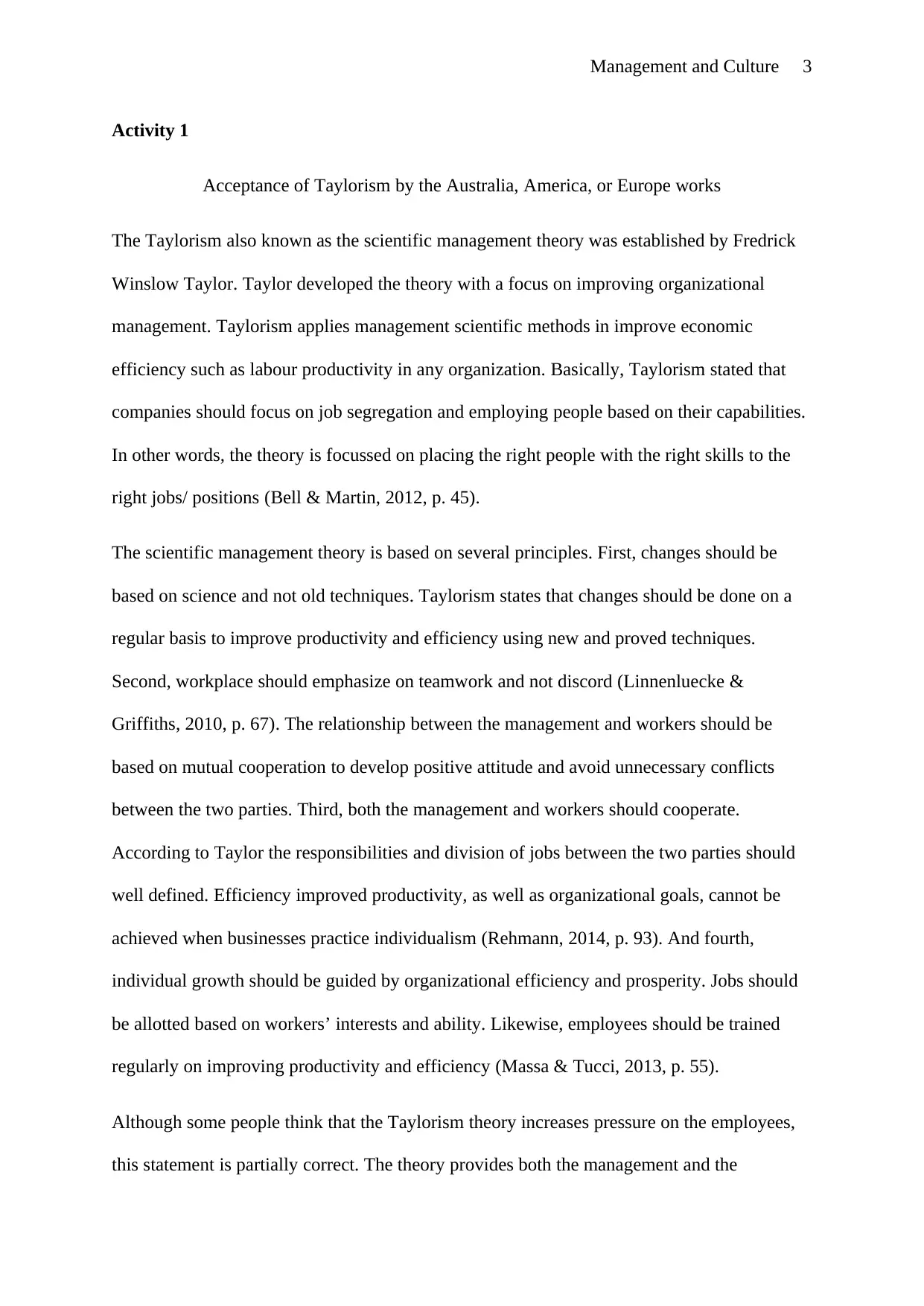
Management and Culture 3
Activity 1
Acceptance of Taylorism by the Australia, America, or Europe works
The Taylorism also known as the scientific management theory was established by Fredrick
Winslow Taylor. Taylor developed the theory with a focus on improving organizational
management. Taylorism applies management scientific methods in improve economic
efficiency such as labour productivity in any organization. Basically, Taylorism stated that
companies should focus on job segregation and employing people based on their capabilities.
In other words, the theory is focussed on placing the right people with the right skills to the
right jobs/ positions (Bell & Martin, 2012, p. 45).
The scientific management theory is based on several principles. First, changes should be
based on science and not old techniques. Taylorism states that changes should be done on a
regular basis to improve productivity and efficiency using new and proved techniques.
Second, workplace should emphasize on teamwork and not discord (Linnenluecke &
Griffiths, 2010, p. 67). The relationship between the management and workers should be
based on mutual cooperation to develop positive attitude and avoid unnecessary conflicts
between the two parties. Third, both the management and workers should cooperate.
According to Taylor the responsibilities and division of jobs between the two parties should
well defined. Efficiency improved productivity, as well as organizational goals, cannot be
achieved when businesses practice individualism (Rehmann, 2014, p. 93). And fourth,
individual growth should be guided by organizational efficiency and prosperity. Jobs should
be allotted based on workers’ interests and ability. Likewise, employees should be trained
regularly on improving productivity and efficiency (Massa & Tucci, 2013, p. 55).
Although some people think that the Taylorism theory increases pressure on the employees,
this statement is partially correct. The theory provides both the management and the
Activity 1
Acceptance of Taylorism by the Australia, America, or Europe works
The Taylorism also known as the scientific management theory was established by Fredrick
Winslow Taylor. Taylor developed the theory with a focus on improving organizational
management. Taylorism applies management scientific methods in improve economic
efficiency such as labour productivity in any organization. Basically, Taylorism stated that
companies should focus on job segregation and employing people based on their capabilities.
In other words, the theory is focussed on placing the right people with the right skills to the
right jobs/ positions (Bell & Martin, 2012, p. 45).
The scientific management theory is based on several principles. First, changes should be
based on science and not old techniques. Taylorism states that changes should be done on a
regular basis to improve productivity and efficiency using new and proved techniques.
Second, workplace should emphasize on teamwork and not discord (Linnenluecke &
Griffiths, 2010, p. 67). The relationship between the management and workers should be
based on mutual cooperation to develop positive attitude and avoid unnecessary conflicts
between the two parties. Third, both the management and workers should cooperate.
According to Taylor the responsibilities and division of jobs between the two parties should
well defined. Efficiency improved productivity, as well as organizational goals, cannot be
achieved when businesses practice individualism (Rehmann, 2014, p. 93). And fourth,
individual growth should be guided by organizational efficiency and prosperity. Jobs should
be allotted based on workers’ interests and ability. Likewise, employees should be trained
regularly on improving productivity and efficiency (Massa & Tucci, 2013, p. 55).
Although some people think that the Taylorism theory increases pressure on the employees,
this statement is partially correct. The theory provides both the management and the
⊘ This is a preview!⊘
Do you want full access?
Subscribe today to unlock all pages.

Trusted by 1+ million students worldwide
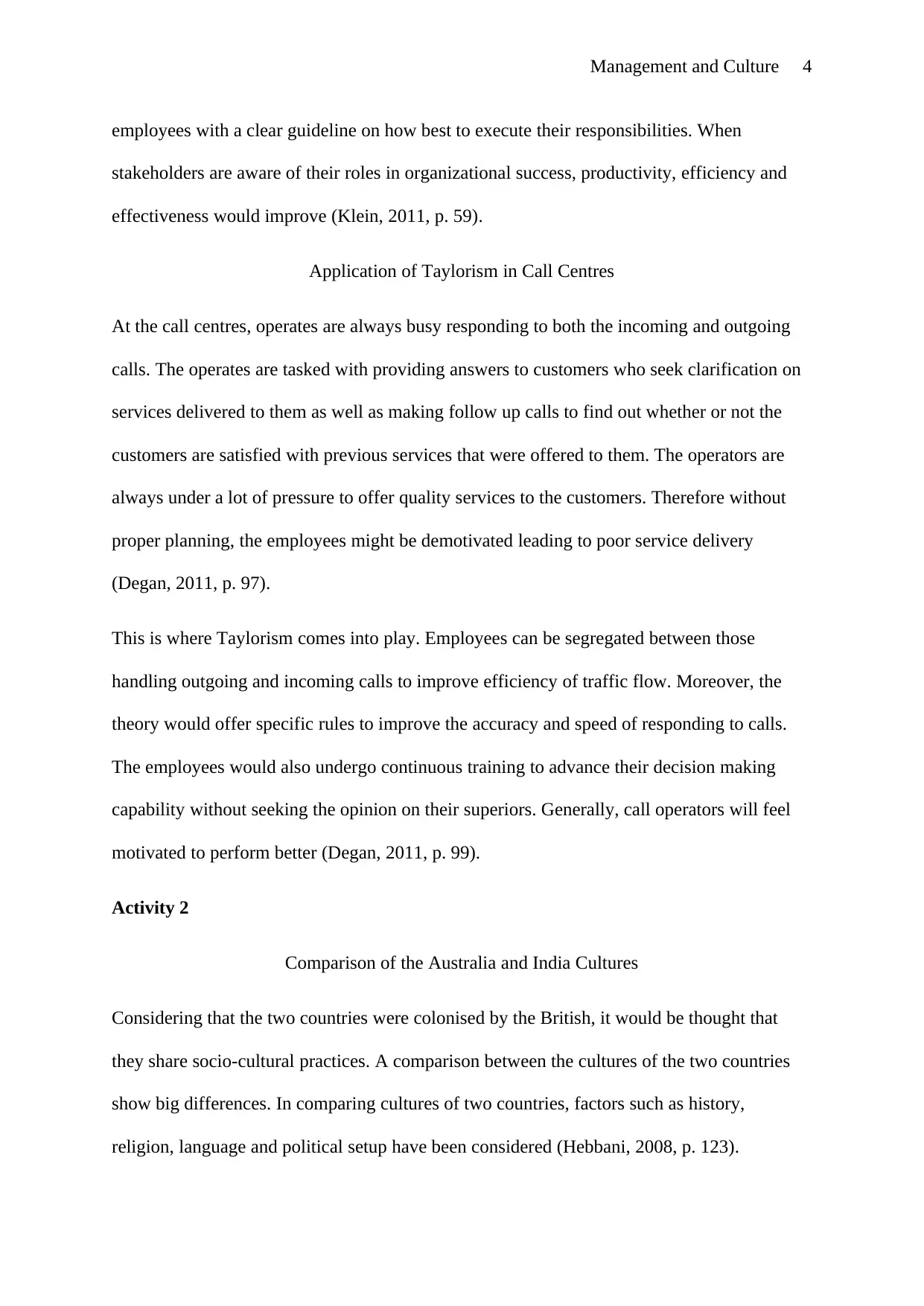
Management and Culture 4
employees with a clear guideline on how best to execute their responsibilities. When
stakeholders are aware of their roles in organizational success, productivity, efficiency and
effectiveness would improve (Klein, 2011, p. 59).
Application of Taylorism in Call Centres
At the call centres, operates are always busy responding to both the incoming and outgoing
calls. The operates are tasked with providing answers to customers who seek clarification on
services delivered to them as well as making follow up calls to find out whether or not the
customers are satisfied with previous services that were offered to them. The operators are
always under a lot of pressure to offer quality services to the customers. Therefore without
proper planning, the employees might be demotivated leading to poor service delivery
(Degan, 2011, p. 97).
This is where Taylorism comes into play. Employees can be segregated between those
handling outgoing and incoming calls to improve efficiency of traffic flow. Moreover, the
theory would offer specific rules to improve the accuracy and speed of responding to calls.
The employees would also undergo continuous training to advance their decision making
capability without seeking the opinion on their superiors. Generally, call operators will feel
motivated to perform better (Degan, 2011, p. 99).
Activity 2
Comparison of the Australia and India Cultures
Considering that the two countries were colonised by the British, it would be thought that
they share socio-cultural practices. A comparison between the cultures of the two countries
show big differences. In comparing cultures of two countries, factors such as history,
religion, language and political setup have been considered (Hebbani, 2008, p. 123).
employees with a clear guideline on how best to execute their responsibilities. When
stakeholders are aware of their roles in organizational success, productivity, efficiency and
effectiveness would improve (Klein, 2011, p. 59).
Application of Taylorism in Call Centres
At the call centres, operates are always busy responding to both the incoming and outgoing
calls. The operates are tasked with providing answers to customers who seek clarification on
services delivered to them as well as making follow up calls to find out whether or not the
customers are satisfied with previous services that were offered to them. The operators are
always under a lot of pressure to offer quality services to the customers. Therefore without
proper planning, the employees might be demotivated leading to poor service delivery
(Degan, 2011, p. 97).
This is where Taylorism comes into play. Employees can be segregated between those
handling outgoing and incoming calls to improve efficiency of traffic flow. Moreover, the
theory would offer specific rules to improve the accuracy and speed of responding to calls.
The employees would also undergo continuous training to advance their decision making
capability without seeking the opinion on their superiors. Generally, call operators will feel
motivated to perform better (Degan, 2011, p. 99).
Activity 2
Comparison of the Australia and India Cultures
Considering that the two countries were colonised by the British, it would be thought that
they share socio-cultural practices. A comparison between the cultures of the two countries
show big differences. In comparing cultures of two countries, factors such as history,
religion, language and political setup have been considered (Hebbani, 2008, p. 123).
Paraphrase This Document
Need a fresh take? Get an instant paraphrase of this document with our AI Paraphraser
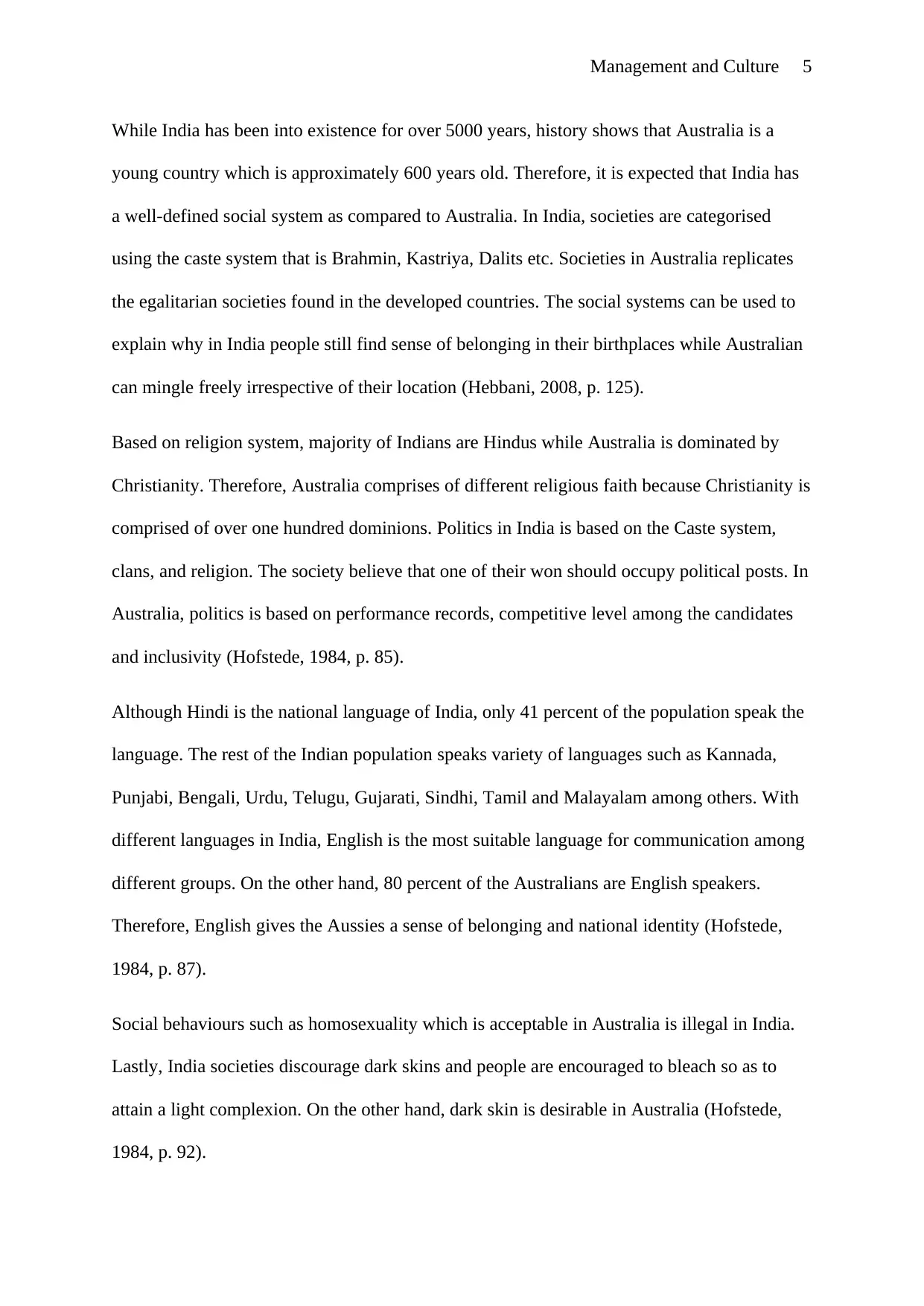
Management and Culture 5
While India has been into existence for over 5000 years, history shows that Australia is a
young country which is approximately 600 years old. Therefore, it is expected that India has
a well-defined social system as compared to Australia. In India, societies are categorised
using the caste system that is Brahmin, Kastriya, Dalits etc. Societies in Australia replicates
the egalitarian societies found in the developed countries. The social systems can be used to
explain why in India people still find sense of belonging in their birthplaces while Australian
can mingle freely irrespective of their location (Hebbani, 2008, p. 125).
Based on religion system, majority of Indians are Hindus while Australia is dominated by
Christianity. Therefore, Australia comprises of different religious faith because Christianity is
comprised of over one hundred dominions. Politics in India is based on the Caste system,
clans, and religion. The society believe that one of their won should occupy political posts. In
Australia, politics is based on performance records, competitive level among the candidates
and inclusivity (Hofstede, 1984, p. 85).
Although Hindi is the national language of India, only 41 percent of the population speak the
language. The rest of the Indian population speaks variety of languages such as Kannada,
Punjabi, Bengali, Urdu, Telugu, Gujarati, Sindhi, Tamil and Malayalam among others. With
different languages in India, English is the most suitable language for communication among
different groups. On the other hand, 80 percent of the Australians are English speakers.
Therefore, English gives the Aussies a sense of belonging and national identity (Hofstede,
1984, p. 87).
Social behaviours such as homosexuality which is acceptable in Australia is illegal in India.
Lastly, India societies discourage dark skins and people are encouraged to bleach so as to
attain a light complexion. On the other hand, dark skin is desirable in Australia (Hofstede,
1984, p. 92).
While India has been into existence for over 5000 years, history shows that Australia is a
young country which is approximately 600 years old. Therefore, it is expected that India has
a well-defined social system as compared to Australia. In India, societies are categorised
using the caste system that is Brahmin, Kastriya, Dalits etc. Societies in Australia replicates
the egalitarian societies found in the developed countries. The social systems can be used to
explain why in India people still find sense of belonging in their birthplaces while Australian
can mingle freely irrespective of their location (Hebbani, 2008, p. 125).
Based on religion system, majority of Indians are Hindus while Australia is dominated by
Christianity. Therefore, Australia comprises of different religious faith because Christianity is
comprised of over one hundred dominions. Politics in India is based on the Caste system,
clans, and religion. The society believe that one of their won should occupy political posts. In
Australia, politics is based on performance records, competitive level among the candidates
and inclusivity (Hofstede, 1984, p. 85).
Although Hindi is the national language of India, only 41 percent of the population speak the
language. The rest of the Indian population speaks variety of languages such as Kannada,
Punjabi, Bengali, Urdu, Telugu, Gujarati, Sindhi, Tamil and Malayalam among others. With
different languages in India, English is the most suitable language for communication among
different groups. On the other hand, 80 percent of the Australians are English speakers.
Therefore, English gives the Aussies a sense of belonging and national identity (Hofstede,
1984, p. 87).
Social behaviours such as homosexuality which is acceptable in Australia is illegal in India.
Lastly, India societies discourage dark skins and people are encouraged to bleach so as to
attain a light complexion. On the other hand, dark skin is desirable in Australia (Hofstede,
1984, p. 92).
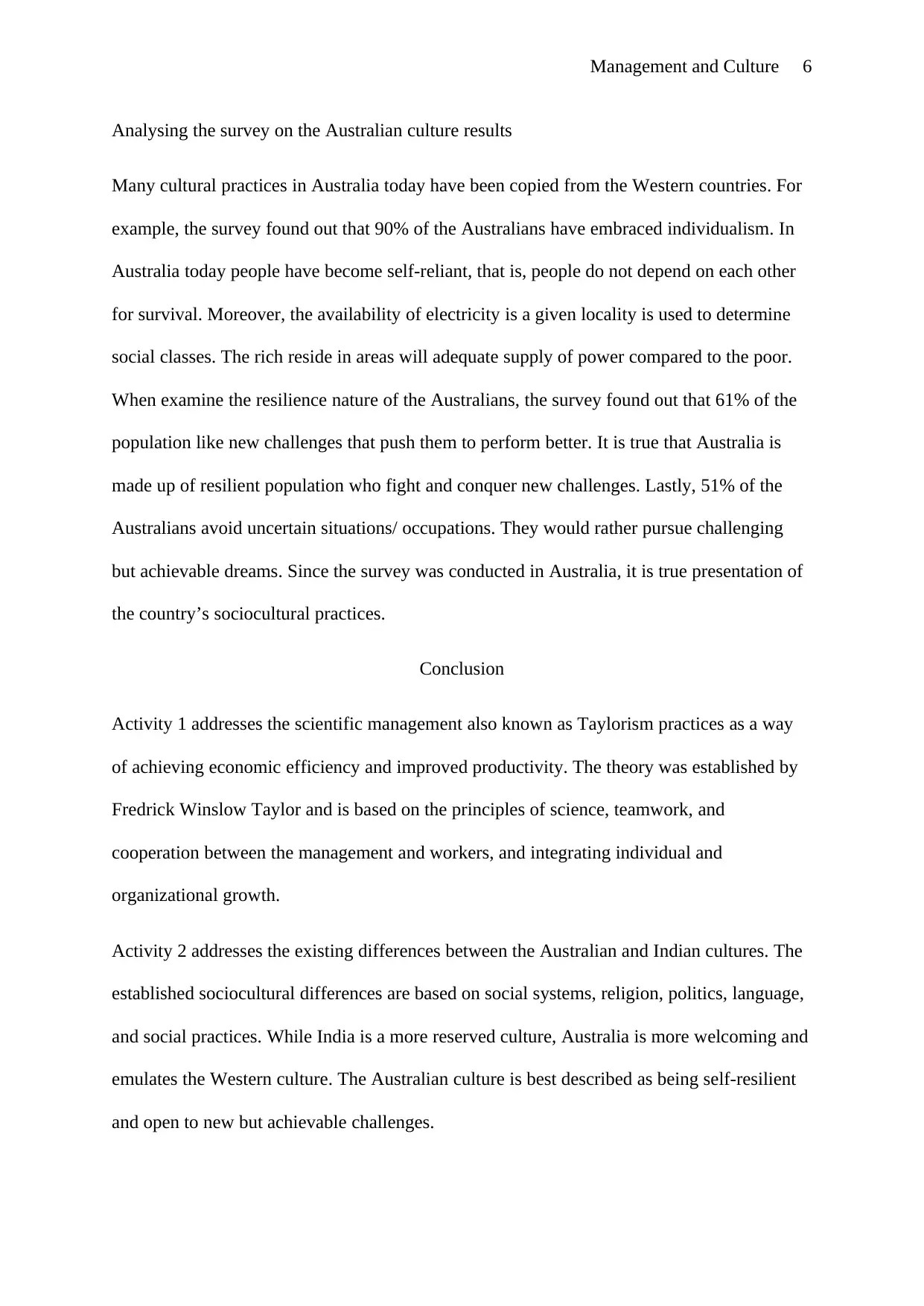
Management and Culture 6
Analysing the survey on the Australian culture results
Many cultural practices in Australia today have been copied from the Western countries. For
example, the survey found out that 90% of the Australians have embraced individualism. In
Australia today people have become self-reliant, that is, people do not depend on each other
for survival. Moreover, the availability of electricity is a given locality is used to determine
social classes. The rich reside in areas will adequate supply of power compared to the poor.
When examine the resilience nature of the Australians, the survey found out that 61% of the
population like new challenges that push them to perform better. It is true that Australia is
made up of resilient population who fight and conquer new challenges. Lastly, 51% of the
Australians avoid uncertain situations/ occupations. They would rather pursue challenging
but achievable dreams. Since the survey was conducted in Australia, it is true presentation of
the country’s sociocultural practices.
Conclusion
Activity 1 addresses the scientific management also known as Taylorism practices as a way
of achieving economic efficiency and improved productivity. The theory was established by
Fredrick Winslow Taylor and is based on the principles of science, teamwork, and
cooperation between the management and workers, and integrating individual and
organizational growth.
Activity 2 addresses the existing differences between the Australian and Indian cultures. The
established sociocultural differences are based on social systems, religion, politics, language,
and social practices. While India is a more reserved culture, Australia is more welcoming and
emulates the Western culture. The Australian culture is best described as being self-resilient
and open to new but achievable challenges.
Analysing the survey on the Australian culture results
Many cultural practices in Australia today have been copied from the Western countries. For
example, the survey found out that 90% of the Australians have embraced individualism. In
Australia today people have become self-reliant, that is, people do not depend on each other
for survival. Moreover, the availability of electricity is a given locality is used to determine
social classes. The rich reside in areas will adequate supply of power compared to the poor.
When examine the resilience nature of the Australians, the survey found out that 61% of the
population like new challenges that push them to perform better. It is true that Australia is
made up of resilient population who fight and conquer new challenges. Lastly, 51% of the
Australians avoid uncertain situations/ occupations. They would rather pursue challenging
but achievable dreams. Since the survey was conducted in Australia, it is true presentation of
the country’s sociocultural practices.
Conclusion
Activity 1 addresses the scientific management also known as Taylorism practices as a way
of achieving economic efficiency and improved productivity. The theory was established by
Fredrick Winslow Taylor and is based on the principles of science, teamwork, and
cooperation between the management and workers, and integrating individual and
organizational growth.
Activity 2 addresses the existing differences between the Australian and Indian cultures. The
established sociocultural differences are based on social systems, religion, politics, language,
and social practices. While India is a more reserved culture, Australia is more welcoming and
emulates the Western culture. The Australian culture is best described as being self-resilient
and open to new but achievable challenges.
⊘ This is a preview!⊘
Do you want full access?
Subscribe today to unlock all pages.

Trusted by 1+ million students worldwide
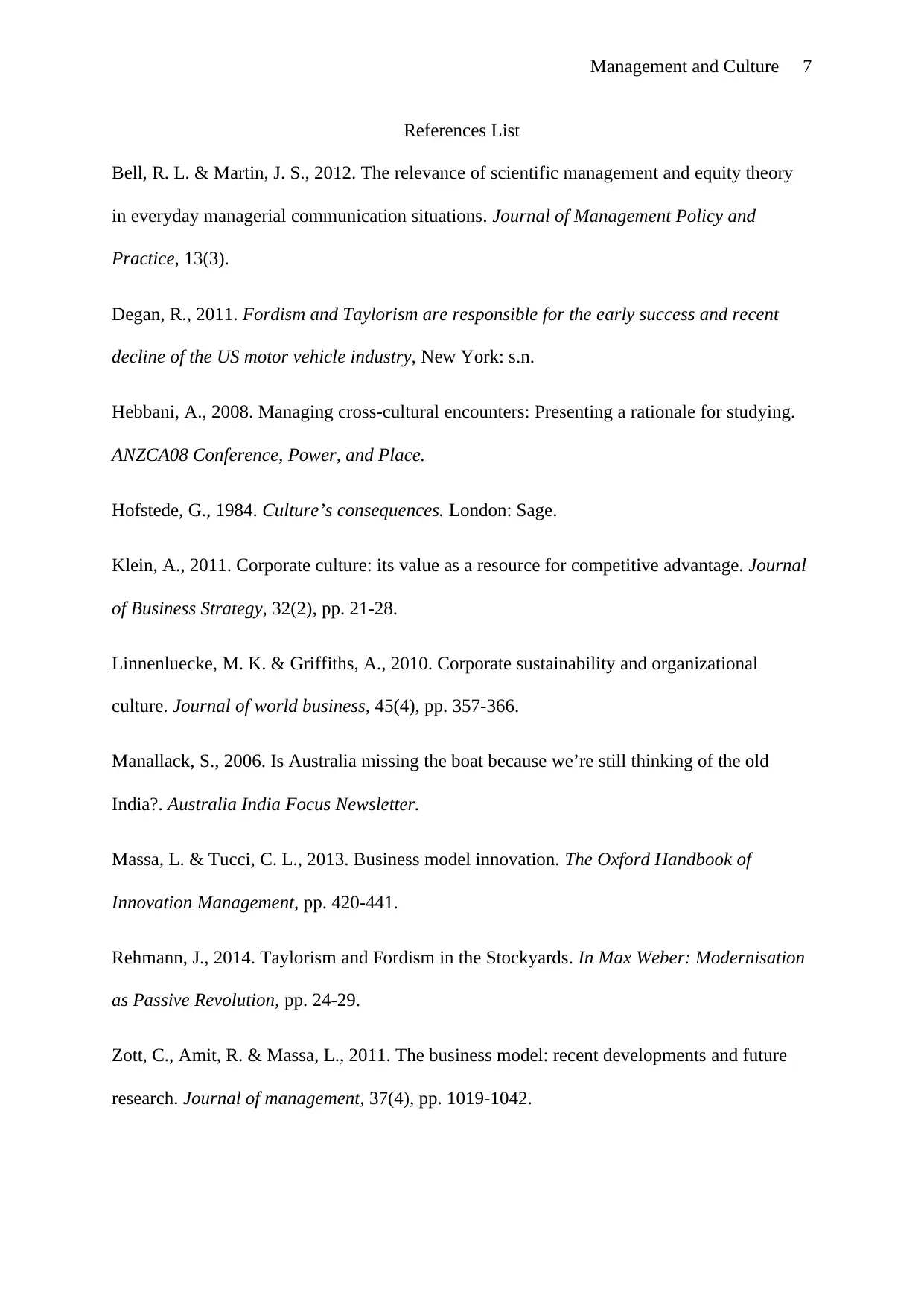
Management and Culture 7
References List
Bell, R. L. & Martin, J. S., 2012. The relevance of scientific management and equity theory
in everyday managerial communication situations. Journal of Management Policy and
Practice, 13(3).
Degan, R., 2011. Fordism and Taylorism are responsible for the early success and recent
decline of the US motor vehicle industry, New York: s.n.
Hebbani, A., 2008. Managing cross-cultural encounters: Presenting a rationale for studying.
ANZCA08 Conference, Power, and Place.
Hofstede, G., 1984. Culture’s consequences. London: Sage.
Klein, A., 2011. Corporate culture: its value as a resource for competitive advantage. Journal
of Business Strategy, 32(2), pp. 21-28.
Linnenluecke, M. K. & Griffiths, A., 2010. Corporate sustainability and organizational
culture. Journal of world business, 45(4), pp. 357-366.
Manallack, S., 2006. Is Australia missing the boat because we’re still thinking of the old
India?. Australia India Focus Newsletter.
Massa, L. & Tucci, C. L., 2013. Business model innovation. The Oxford Handbook of
Innovation Management, pp. 420-441.
Rehmann, J., 2014. Taylorism and Fordism in the Stockyards. In Max Weber: Modernisation
as Passive Revolution, pp. 24-29.
Zott, C., Amit, R. & Massa, L., 2011. The business model: recent developments and future
research. Journal of management, 37(4), pp. 1019-1042.
References List
Bell, R. L. & Martin, J. S., 2012. The relevance of scientific management and equity theory
in everyday managerial communication situations. Journal of Management Policy and
Practice, 13(3).
Degan, R., 2011. Fordism and Taylorism are responsible for the early success and recent
decline of the US motor vehicle industry, New York: s.n.
Hebbani, A., 2008. Managing cross-cultural encounters: Presenting a rationale for studying.
ANZCA08 Conference, Power, and Place.
Hofstede, G., 1984. Culture’s consequences. London: Sage.
Klein, A., 2011. Corporate culture: its value as a resource for competitive advantage. Journal
of Business Strategy, 32(2), pp. 21-28.
Linnenluecke, M. K. & Griffiths, A., 2010. Corporate sustainability and organizational
culture. Journal of world business, 45(4), pp. 357-366.
Manallack, S., 2006. Is Australia missing the boat because we’re still thinking of the old
India?. Australia India Focus Newsletter.
Massa, L. & Tucci, C. L., 2013. Business model innovation. The Oxford Handbook of
Innovation Management, pp. 420-441.
Rehmann, J., 2014. Taylorism and Fordism in the Stockyards. In Max Weber: Modernisation
as Passive Revolution, pp. 24-29.
Zott, C., Amit, R. & Massa, L., 2011. The business model: recent developments and future
research. Journal of management, 37(4), pp. 1019-1042.
1 out of 7
Related Documents
Your All-in-One AI-Powered Toolkit for Academic Success.
+13062052269
info@desklib.com
Available 24*7 on WhatsApp / Email
![[object Object]](/_next/static/media/star-bottom.7253800d.svg)
Unlock your academic potential
Copyright © 2020–2025 A2Z Services. All Rights Reserved. Developed and managed by ZUCOL.





